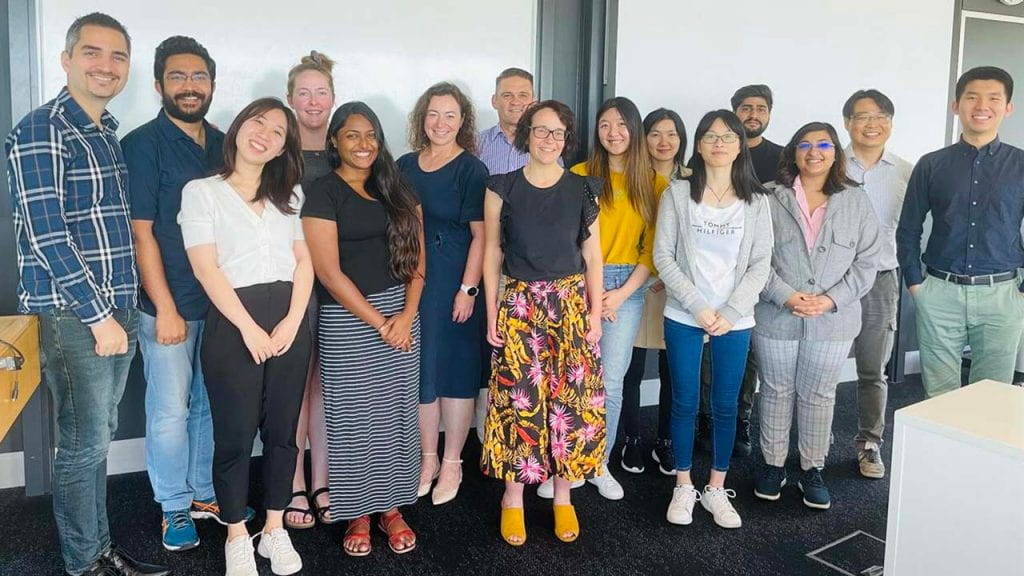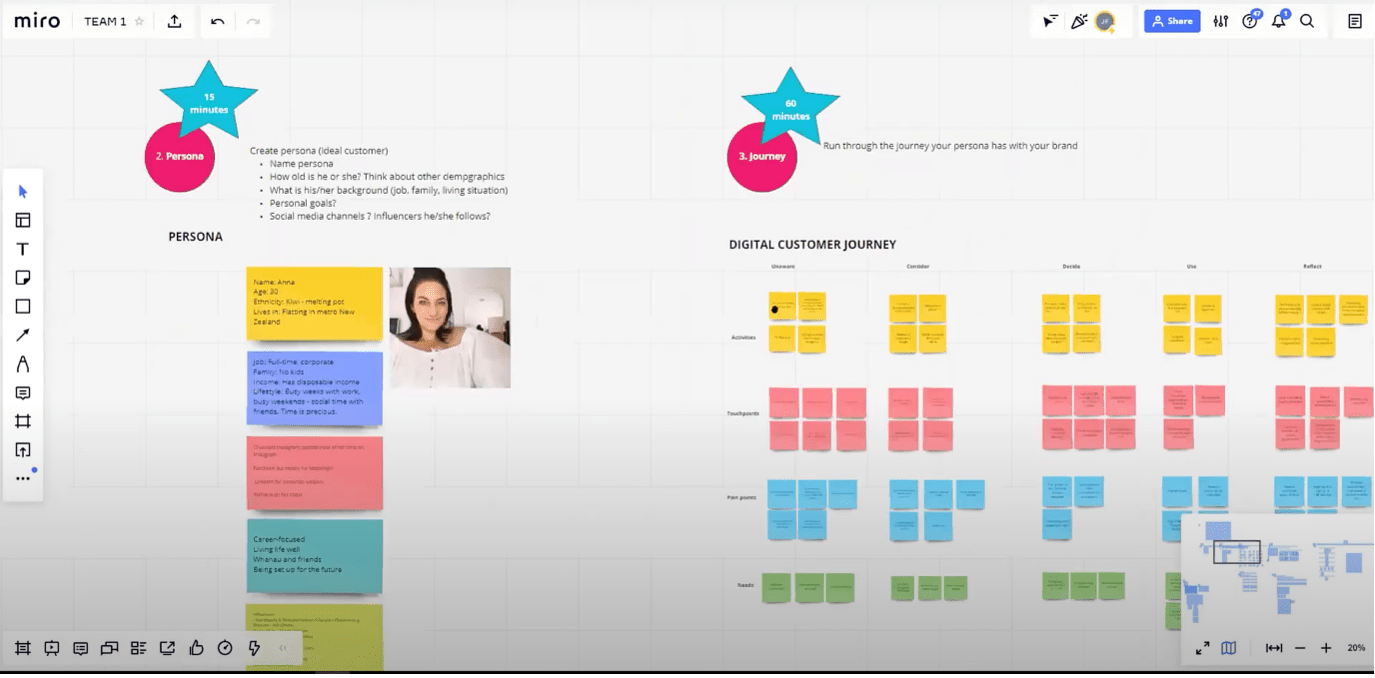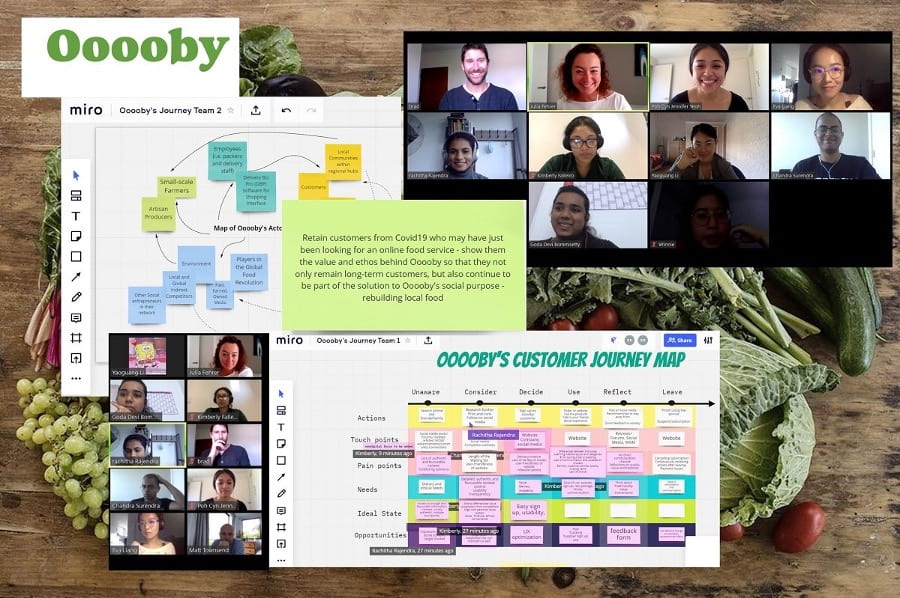Team collaboration using Miro in Marketing and Strategy courses
To gain concrete experiences, students work collaboratively in groups to develop marketing strategies for real cases and clients using Miro interactive online board.
Dr Julia Fehrer is Associate Professor of Innovation and Strategy. She was awarded the Early Career Excellence in Teaching Award in 2020. She develops and teaches Marketing and Strategy courses at the Business School. These courses offer transformational (research-led) learning and teaching practices. They create ‘Aha’ moments for students through the interaction with practitioners from leading companies, who present real-life problems. Students develop capabilities to form solutions by working as project teams and deliver a pitch to their industry clients.
The courses designed digital first for digital or hybrid delivery, and focus on project-based and design-led learning with predefined milestones and based on ‘group contracts’, which define the responsibilities of each student in the team.

Background
Julia works with cohorts consisting of adult learners from various cultural backgrounds that bring rich professional and live experiences, which form the foundation of their learning. Postgraduate students analyse, rationalize, synthesize, and develop new ideas or tweak old ones through the filter of their experiences. Thus, it is central in the course design that students tap into their experiences to help them make connections, perceive relevance, and derive inspiration1 2. At the same time, it is essential to set new flashes of inspiration through new marketing theories and strategic approaches, such as Service‐Dominant Logic and Design Thinking, to let them see reality in new ways and break with existing thought patterns.
Working with real clients and digital tools like Miro, that are used in industry practice is a win-win situation with great value for the students who gain real-life marketing experience. New Zealand companies that receive strategic marketing recommendations often connect with talented students, and the University of Auckland broadens its business network. This way of bringing students together with business partners has resulted in multiple internships and permanent student positions.
Design and implementation
How it works?
After students went through a module on Marketing Strategy and a module on Design Thinking In Canvas, students receive the following instructions:
We will use the Miro Whiteboard for the design sprints.
You will receive an invitation for your Miro board via email.
Design sprints are scheduled for two three-hour sessions.
If the course is digital only: We will run these sessions via Zoom.
The first session introduces digital customer journey mapping. Students draw and describe personas, depict customers/stakeholders in their clients’ ecosystems and map customers’ activities along a digital journey.
The second session requires students to evaluate potential digital business opportunities based on identified customer needs. They learn to prioritise business opportunities and follow a rapid prototyping process with the most promising ideas. These workshops are extremely intense and fast-paced; nevertheless, the students enjoy them.
After the workshops, they reflect on their findings and combine them with digital marketing frameworks, analytics, modelling and CRM database knowledge to develop a digital marketing strategy for their clients.
Video: Julia introducing contemporary marketing modules to students (5:07)
Learning with practitioners
What students highly enjoy is not only learning with their peers but also with experienced practitioners. Partnering with IBM, Google, Microsoft, AKQA, and PureSEO to create a learning experience that reflects contemporary marketing challenges, ensures state-of-the-art content and provides students with unique opportunities to understand marketing from an academic perspective and ‘on the job’.
Project-based assignments, such as project reports and pitches to real clients, effectively develops strategic, team and leadership skills that postgraduate students need for their marketing careers.
One of real clients in the Digital Marketing course was St. John. Students worked with St. John to develop strategies and integrated digital marketing campaigns to increase community engagement specifically in the dialog with Māori and Pacific communities to foster health equality in Aotearoa. Students used the Miro board as knowledge base and tool to coordinate team work throughout the courses. The course started with two three-hour structured design sprint sessions on Miro. Students were introduced to marketing and design theory before the design sprints started. During the design sprints, they used templates provided on Miro to go through a structured process of:
(1) clarifying the problem, (2) defining a persona, (3) creating a customer journey map and (4) prioritizing business opportunities arising from understanding the customer journey.
These design sprints are high pace and high energy. They are inspired by industry practice. Julia worked over the last five years with Matt Townsend – Executive Strategy Director AUNZ (AKQA) one of the world leading digital design and communication agencies to develop and refine this design-led learning method.
Reflection
Setting up an interactive design-led course does not come without challenges (Julia’s 4 cents):
- Using technologies, such as Miro can be scary for students. It is important to introduce the tools properly and link a mini task at the beginning of the course to them to ensure every student before they come to the group workshops have familiarised themselves with the tool
- Students sometimes feel uncomfortable in team settings, especially, when they have a lot of creative freedom. Design-led learning means, we don’t know the outcome of a design process when we start the process. This means, it is important that students can trust the design process. Processes and templates need to be really clear.
- Creating Youtube videos, how to use templates can be highly beneficial.
- Providing students with exemplars with outcomes from previous group work can reduce perceived uncertainty
- Students need to be ready for the client. Before the client comes in, students need to familiarise themselves with the client’s business model and be prepared with questions (this can be linked to an assignment
- Assignments should include project milestones and group contracts (with defined escalation process) to avoid last minute delivery or piggybacking. Working with a ‘rehearsal’ (small amount of grades can be allocated to that) one week before the client pitch can help keep groups on track.
Peer review
“Julia gave an overview then went step by step through the process that the students will need to follow in the group exercise. This approach caters for different thinking and learning styles. The class were given a time limit as well which is always helpful for group work. After the break they were encouraged to register on their Miro boards (one for each team). Julia had prepared templates on the Miro boards for each of the three tasks of the first session” … ”In the selection of the problem that they are going to work on in groups the students are encouraged and expected to draw on their prior knowledge and experience of a real‐life problem from their current work situation. Throughout the session, Julia built on the participants’ practical experience. Importantly, through the group setting, Julia created an atmosphere where the more experienced participants shared their experience and the less experienced participants learned from their peers with regard to both content and software”
Una Lightfoot, Curriculum Development Manager – 15 August 2021
Further resources
Presentation at Innovative Learning and Teaching (ILT) LEARN DO SHARE 2021. Topic: Miro, Miro on the Wall: How to organize group work in online teaching sessions using the Miro whiteboard tool.
Dumford, A. D., & Miller, A. L. (2018). Online learning in higher education: exploring advantages and disadvantages for engagement. Journal of Computing in Higher Education, 30(3), 452-465.
Garrison, D. R. (2007). Online community of inquiry review: Social, cognitive, and teaching presence issues. Journal of Asynchronous Learning Networks, 11(1), 61-72.
Janssen, J., & Kirschner, P. A. (2020). Applying collaborative cognitive load theory to computer-supported collaborative learning: towards a research agenda. Educational Technology Research and Development, 1-23.
Kolb, D. A., Boyatzis, R. E., & Mainemelis, C. (2014). Experiential learning theory: Previous research and new directions. In Sternberg, R. J., & Zhang, L. F. (Eds.), Perspectives on thinking, learning, and cognitive styles (pp. 227-248). Routledge.



